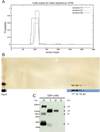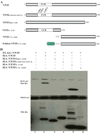Homo-oligomerization facilitates the interferon-antagonist activity of the ebolavirus VP35 protein
- PMID: 16095644
- PMCID: PMC3955989
- DOI: 10.1016/j.virol.2005.06.044
Homo-oligomerization facilitates the interferon-antagonist activity of the ebolavirus VP35 protein
Abstract
We have identified a putative coiled-coil motif within the amino-terminal half of the ebolavirus VP35 protein. Cross-linking studies demonstrated the ability of VP35 to form trimers, consistent with the presence of a functional coiled-coil motif. VP35 mutants lacking the coiled-coil motif or possessing a mutation designed to disrupt coiled-coil function were defective in oligomerization, as deduced by co-immunoprecipitation studies. VP35 inhibits signaling that activates interferon regulatory factor 3 (IRF-3) and inhibits (IFN)-alpha/beta production. Experiments comparing the ability of VP35 mutants to block IFN responses demonstrated that the VP35 amino-terminus, which retains the putative coiled-coil motif, was unable to inhibit IFN responses, whereas the VP35 carboxy-terminus weakly inhibited the activation of IFN responses. IFN-antagonist function was restored when a heterologous trimerization motif was fused to the carboxy-terminal half of VP35, suggesting that an oligomerization function at the amino-terminus facilitates an "IFN-antagonist" function exerted by the carboxy-terminal half of VP35.
Figures





Similar articles
-
Insights into the homo-oligomerization properties of N-terminal coiled-coil domain of Ebola virus VP35 protein.Virus Res. 2018 Mar 2;247:61-70. doi: 10.1016/j.virusres.2018.02.003. Epub 2018 Feb 7. Virus Res. 2018. PMID: 29427597
-
Basic residues within the ebolavirus VP35 protein are required for its viral polymerase cofactor function.J Virol. 2010 Oct;84(20):10581-91. doi: 10.1128/JVI.00925-10. Epub 2010 Aug 4. J Virol. 2010. PMID: 20686031 Free PMC article.
-
Expression, purification, crystallization and preliminary X-ray studies of the Ebola VP35 interferon inhibitory domain.Acta Crystallogr Sect F Struct Biol Cryst Commun. 2009 Feb 1;65(Pt 2):163-5. doi: 10.1107/S1744309108044187. Epub 2009 Jan 31. Acta Crystallogr Sect F Struct Biol Cryst Commun. 2009. PMID: 19194011 Free PMC article.
-
Evasion of interferon responses by Ebola and Marburg viruses.J Interferon Cytokine Res. 2009 Sep;29(9):511-20. doi: 10.1089/jir.2009.0076. J Interferon Cytokine Res. 2009. PMID: 19694547 Free PMC article. Review.
-
Insights into Ebola Virus VP35 and VP24 Interferon Inhibitory Functions and their Initial Exploitation as Drug Targets.Infect Disord Drug Targets. 2019;19(4):362-374. doi: 10.2174/1871526519666181123145540. Infect Disord Drug Targets. 2019. PMID: 30468131 Review.
Cited by
-
Origin, Evolution and Diversity of φ29-like Phages-Review and Bioinformatic Analysis.Int J Mol Sci. 2024 Oct 9;25(19):10838. doi: 10.3390/ijms251910838. Int J Mol Sci. 2024. PMID: 39409167 Free PMC article. Review.
-
Ebola virus VP35 interacts non-covalently with ubiquitin chains to promote viral replication.PLoS Biol. 2024 Feb 29;22(2):e3002544. doi: 10.1371/journal.pbio.3002544. eCollection 2024 Feb. PLoS Biol. 2024. PMID: 38422166 Free PMC article.
-
Relevance of Ebola virus VP35 homo-dimerization on the type I interferon cascade inhibition.Antivir Chem Chemother. 2019 Jan-Dec;27:2040206619889220. doi: 10.1177/2040206619889220. Antivir Chem Chemother. 2019. PMID: 31744306 Free PMC article.
-
The importance of the NP: VP35 ratio in Ebola virus nucleocapsid formation.J Infect Dis. 2011 Nov;204 Suppl 3(Suppl 3):S878-83. doi: 10.1093/infdis/jir310. J Infect Dis. 2011. PMID: 21987764 Free PMC article.
-
The Host E3-Ubiquitin Ligase TRIM6 Ubiquitinates the Ebola Virus VP35 Protein and Promotes Virus Replication.J Virol. 2017 Aug 24;91(18):e00833-17. doi: 10.1128/JVI.00833-17. Print 2017 Sep 15. J Virol. 2017. PMID: 28679761 Free PMC article.
References
-
- Bosio CM, Aman MJ, Grogan C, Hogan R, Ruthel G, Negley D, Mohamadzadeh M, Bavari S, Schmaljohn A. Ebola and Marburg viruses replicate in monocytederived dendritic cells without inducing the production of cytokines and full maturation. J Infect Dis. 2003;188(11):1630–1638. - PubMed
Publication types
MeSH terms
Substances
Grants and funding
LinkOut - more resources
Full Text Sources
Medical

